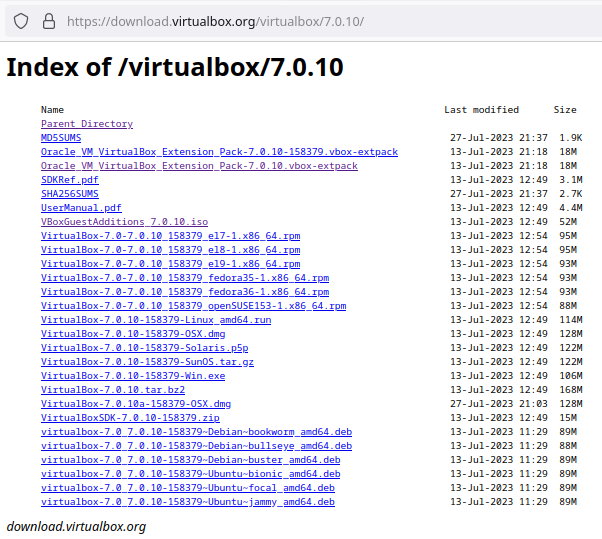If your computer is a Linux, QEMU/KVM with libvirtd is great. If you run a Windows 10 or higher, HyperV works great, you should also be able to grab a VMware Player if it's still free. For Mac you have Parallels I believe.
Linux
From Wikipedia, the free encyclopedia
Linux is a family of open source Unix-like operating systems based on the Linux kernel, an operating system kernel first released on September 17, 1991 by Linus Torvalds. Linux is typically packaged in a Linux distribution (or distro for short).
Distributions include the Linux kernel and supporting system software and libraries, many of which are provided by the GNU Project. Many Linux distributions use the word "Linux" in their name, but the Free Software Foundation uses the name GNU/Linux to emphasize the importance of GNU software, causing some controversy.
Rules
- Posts must be relevant to operating systems running the Linux kernel. GNU/Linux or otherwise.
- No misinformation
- No NSFW content
- No hate speech, bigotry, etc
Related Communities
Community icon by Alpár-Etele Méder, licensed under CC BY 3.0
Gnome Boxes is also great for simple stuff on Linux. Besides there is virt-manager as GUI for libvirt. On macOS UTM is a good free and open source tool.
Sorry I meant virt-manager yeah, I think it is part of libvirtd
I'll try it
HyperV doesn't let you adjust the screen size does it? I tried to use it for work but that held me back
I believe you need to install the drivers for it. Something similar to vmwaretools but for hyperv.
Oh okay, I couldn't even find any screen settings, so I assumed it was just not possible. Thanks, I'll look into it :)
I'd say VirtualBox is still your best bet b/c of its well-polished user interface - ie unless you plan to play games.
very laggy
Had you installed "extension pack" & "guest additions"? If not, please do! They make a world of difference.
Grab them for the version you've installed from VirtualBox downloads directory. Install Oracle_VM_VirtualBox_Extension_Pack-x.y.z.vbox-extpack on your machine and VBoxGuestAdditions_x.y.z.iso on your VM.
For example, for version 7.0.10:

HTH
I've never tried the extension pack, but I do have the guest additions. How do you install it?
Here's a decent guide on how to do it for an Ubuntu VM (instructions should apply to Arch too.) Since you'll be manually downloading guest-additions, just skip the "prerequisites" section.
An here's a guide on how to install the extension pack.
Pray, post here if you run into any troubles (you shouldn't ✌️.)
Thank you! I'll be back if I run into some trouble. :D
Hello, no I haven't installed the packs yet. Will do so, thank you.
You used VBox on Windows, huh? Because it works great on Linux and is absolute garbage on Windows. The distro is secondary here. Try VMWare Workstation Player, there's a free version. Works way better in my experience. As for Arch: Look at Garuda Linux, then try to replicate it on EndeavourOS and you'll know pretty much everything about customizations you need.
alright, thank you
Desktop usage is almost always going to feel laggy in a VM because you don't have a real GPU inside the VM and it will fallback to some non-accelerated framebuffer mode. There are some GPU virtualization solutions, for example QEMU has virgl that offers 3D acceleration, but in my experience it's buggy/not ready and doesn't offer near bare metal performance.
The only way to get near bare metal graphical performance in a VM is by using PCI pass through of an entire GPU, but that requires an extra GPU, is non-trivial to setup and comes with a lot of caveats.
VM has an option to enable GPU acceleration iirc, would that solve it?
Probably not. There are no implementations that I'm aware of that work well on a Linux guest.
Don't worry, if he installs Arch from scratch, it will take him a long time before even having internet connection or installing X.
That's just a meme. If you can follow some basic instructions, you can setup arch.
This. There's archinstall now, too. A bit buggy in my experience so I prefer the old fashioned way.
Dunno why are people spreading this myth... Arch is not that hard to install and you don't get a gold medal for installing it. I installed it with LXDE in an office machine, it only took me an hour.
It depends, I installed it from base, text mode, I had to edit some config file to add my network interface and systemctl restart network etc, then pacman to install X, Xfce, etc, by hand. I guess the best thing is to install Manjaro for instance, it takes a few minutes and you have full GUI and everything.
Fuck Manjaro. EndeavorOS ftw.
Here is an alternative Piped link(s): https://piped.video/watch?v=5KNK3e9ScPo
Piped is a privacy-respecting open-source alternative frontend to YouTube.
I'm open-source, check me out at GitHub.
Have you heard of our lord and savior chroot?
Use KVM and virt manager instead of Virtual box because KVM gives your VM direct access to the bare metal so it runs way better. Virtualbox is running your VM via an abstraction layer which adds overhead and reduces performance.
Just Google how to install KVM on your distro.
Thank you
Do you have prior Linux experience apart from experimenting with Arch in Virtualbox?
I've used Pop_OS!, Mint and a little bit of Ubuntu before
I recommend putting Fedora with your preferred DE on a thumbstick and experimenting with that.
Go to eBay and search “thin clients” - you can get one for about $30, install arch and go nuts.
You should use Debian.